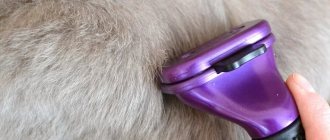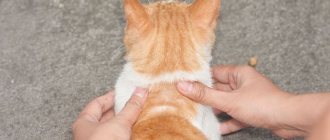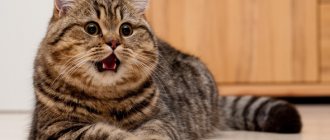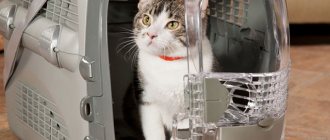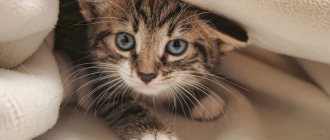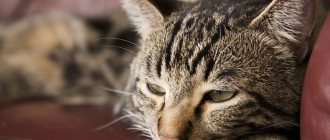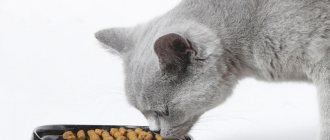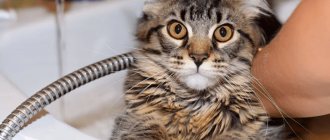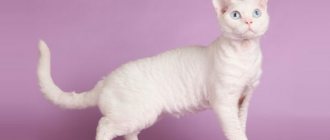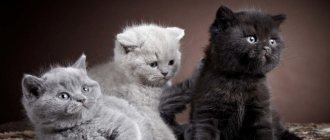Decreased visual acuity and hearing
The first thing that cat owners pay attention to as they age is a decrease in hearing and visual acuity. This is indicated by a number of symptoms:
- Disorientation in familiar space. Increasingly, the cat bumps into furniture and cannot follow the movement of household members and objects.
- Lack of response to loud, annoying sounds.
- The cat does not respond to its name, does not run to the sound of food being poured into a bowl.
- Changes in behavior and the manifestation of aggressive traits are a symptom of hearing loss. This happens for the reason that the cat does not hear the owner approaching her and gets scared.
Owner actions. To help your pet you need to:
- Change the location of the tray and food bowl to make it easier for the animal to navigate.
- Provide the cat with maximum comfort, both moral and physical, and spend more time with her.
- Do not sneak up on your pet from behind, do not get angry if he does not respond to his name. Pets are good at feeling the mood of their owners.
It is imperative to consult a veterinarian. A specialist can prescribe drops for the eyes, ears, and vitamins that help prevent the worsening of pathological processes.
Basic Rules
Experienced owners know that there are external signs of aging in cats , such as graying and fading of the irises of the eyes. If the behavior of an older cat is carefully observed, deterioration in hearing, vision, increased sleep duration and many other changes are noted. It is worth noting that in healthy animals these changes occur slowly and almost imperceptibly.
Even if your pet looks young and vigorous, you should adhere to the general rules. There will be some kind of problem in any case, and the sooner you find it, the better. The basic rules are as follows:
- Take your pet to the vet at least once every six months, even if he looks healthy.
- Even if your cat used to walk outside, stop letting it out . Firstly, self-walking is very dangerous, and secondly, older cats do not tolerate temperature changes well and are more prone to overheating and hypothermia.
- Make sure that your older cat does not lie on cold floors or other surfaces.
- Older cats sleep longer and need rest, so move your pet's bed to a place where it is inaccessible to children, other animals, guests, etc.
- If you notice that your cat is having difficulty walking or standing up, try to pick her up very gently. Inflammatory processes in the joints cause pain even with minor activity.
- Many older cats suffer from urinary incontinence , so take the time and effort to provide each room with a low-sided litter box.
- If you decide to bathe your cat, dry it with a hairdryer or wipe it dry.
Many owners move all the cat's accessories into one room, and this makes sense . When a cat has joint pain, it is much easier for her to eat, drink, rest and go to the toilet within the same room. When remodeling a room, keep in mind that it may be painful for your pet to jump, so either place everything on the floor or make sure that your pet can jump to the right place in several stages, for example, from a chair.
Advice: there is a tradition when one animal grows old and takes another, younger one into the house. It makes sense that when the older pet leaves, you will be left with a four-legged friend. However, you should not wait until your older cat is 9–10 years old; act sooner or refrain from getting a second pet so as not to cause additional stress to the older cat.
Always remember that your pet needs to rest between exercises, but this does not mean that the cat should not receive them. Encourage your cat's desire to play and try to pay enough attention to its activity. Be prepared for your cat to become irritable, especially after big changes (rearranging furniture, moving). If you have to travel or move, think in advance about how to make this event less traumatic for your ward. Stress is very dangerous for older cats.
Wool and skin
Aging cats experience a number of problems with their skin and fur. It should be understood that the changing condition of the coat not only looks unsightly, but also brings a lot of discomfort to the animal:
- Thinning, excessive dryness and flaking of the skin are accompanied by severe and frequent itching. Due to frequent and severe scratching, abrasions and wounds may appear on the epidermis.
- Long-term healing of skin lesions.
- The coat becomes dull, may turn gray and fall out.
- Formation of multiple mats.
How to help ? The owner will be required to perform certain actions:
- Frequent and thorough combing of the coat with special brushes. When combing a fur coat, it is recommended to carefully inspect the skin each time. If any lumps or bumps are noticed on it, this is a reason to immediately contact a veterinarian, since as cats age, there is a high risk of developing cancerous tumors that last for a long time without any symptoms.
- Adding vitamins to the diet to help normalize the condition of the coat and its appearance.
- Treating wounds with disinfectants and applying healing ointments. If the wound on the skin is deep and the cat often scratches it, use topical preparations containing an antibiotic.
Claw care. The animal's claws require no less attention. With age, the nail plate becomes thin and brittle. At the same time, the claws continue to actively grow, but the pet stops regularly grinding them down. Owners need to monitor the length of the cat’s claws and, if necessary, cut them with special scissors.
Teeth and oral cavity
Veterinarians recommend brushing your cat's teeth once every 2 weeks.
For the procedure, a special toothbrush and toothpaste are used, which can be purchased at a pet store. The peculiarity of toothpaste for animals is that it does not need to be washed off with water.
Not all cats like to have their teeth brushed. If the animal reacts inadequately to this procedure, it is recommended to purchase specialized dry food that helps keep the oral cavity clean.
Mobility and games
An aging cat prefers to spend most of its time lying down. But activity and mobility are the key to ensuring that your pet will not have problems with the musculoskeletal system.
The most common disease in older cats is arthritis.
It and a number of other pathologies can be prevented by following medical recommendations:
- Regular games with your pet are required . Even an elderly cat will not refuse to spend time with its owner playing actively with its favorite toy. But you can't overdo it with activity. It should be remembered that the animal gets tired quite quickly.
- Limiting contact with children . If there are small children in the house, it is recommended to protect the cat from frequent contact with them. Elderly pets need peace and quiet. If children frequently tug on your pet, this can cause severe stress, which will further worsen the health condition.
- Arranging a home to suit the needs of an aging pet . Trays, bowls, and the cat's sleeping place should be within easy reach.
- Preventing cats from walking up stairs . It will be difficult for the animal to do this.
- It is important to pay special attention to the litter tray. Many cats find it very difficult to get into a tray with high sides as they age. In such cases, the pet has no choice but to relieve itself near him. You should not scold the animal. It is necessary to purchase a tray with the lowest possible sides.
Elderly cat
Image by Miroslaw Kolaczynski from Pixabay
We are often asked how to care for an older cat. What do old cats get sick with and how do they behave? We are very glad that such questions are asked. This means that pet owners care about their pets. Useful and timely advice for pet owners can be found in books and magazines about keeping and care. We leafed through the files of periodicals and found the best answer to this question in the magazine “Friend of Cats” for 2001. Author of this interesting publication: L. Laslovskaya.
Just a couple of decades ago, a cat that lived 15 years was considered an exceptional long-liver. Today, the average lifespan of a domestic cat is 13-15 years, and cats over 20 years of age are increasingly common. According to statistics from “cat” organizations in America, over the past decade the number of cats that have crossed the 10-year mark has increased by 15%. This is also observed in other countries. This is due to improved care for domestic cats in many areas: the development of veterinary medicine, more comfortable living conditions and, most importantly, changes in cat nutrition. After all, the nutritional needs of a “retired” cat are significantly different from those of a kitten or a cat in its prime. It is worth noting that the life expectancy of the ancestors of the domestic cat, as well as cats that do not have owners and “returned” to nature, is much shorter.
According to the Guinness Book of Records, the longest-living cat, the outbred “English” Puss, passed into another world on November 28, 1939, the day after her 36th birthday! This means that by human standards she was approximately 160 years old. It has been noticed that large cats, including “fat” ones, age earlier than miniature and slender animals. As a rule, purebred “sissies” live less than their domestic relatives. In addition, factors such as lack of physical activity, poor diet and stress shorten a cat's eyelid.
Typically, “retired” cats are much less mobile and do not please the owner with acrobatic jumps. The desire to run, play or hunt decreases with age, and curiosity decreases to a greater or lesser extent.
Grandma cat: what is she like?
“Grandmothers” are considered to be cats over 10 years old. According to experienced owners, it is possible to determine that a cat is of advanced age by looking at its photograph. The expression on the face of a veteran cat is a little tired and “wise”; it differs from the curious faces of kittens and the self-esteemed “faces” of animals in their prime. An elderly cat is unmistakably identified by its behavior, manner of movement and, unfortunately, by various diseases that are common mainly to old animals.
Typically, “retired” cats are much less mobile and do not please the owner with acrobatic jumps. The desire to run, play or hunt decreases with age, and curiosity decreases to a greater or lesser extent. An elderly cat no longer strives, like a young cat, to take part in all events in the life of the owner or to start a game herself, but prefers to lie down and calmly watch what is happening. Many veteran cats suffer from joint diseases, which makes them difficult to move and sometimes limping. An older cat's appetite often deteriorates due to weakened taste and olfactory receptors. Problems with the toilet may also arise: either prolonged constipation or diarrhea. Urination can be painful, difficult, or, on the contrary, too frequent and not always in the litter tray. Vision and hearing may be impaired. In many cats, the quality of their coat deteriorates with age: the once luxurious and thick fur becomes dull and thin, and looks unkempt. Often teeth fall out, gums become inflamed, which causes an unpleasant odor from the cat’s mouth. To this can be added a variety of diseases with characteristic symptoms.
An attentive and loving owner can make the life of his elderly pet much easier, which is not so difficult with the modern development of veterinary medicine and the science of animal nutrition. After all, old age does not mean weakness and illness, it is just another period in life that must be perceived as inevitable.
Gerontology and cats
Gerontology is the science of aging of a living organism. In the last 10-15 years, the increase in the number of older cats and, naturally, age-related diseases has forced veterinarians to establish feline gerontology as a separate discipline. In the USA and England, many veterinary clinics have gerontological departments. Experts recommend once a year a full check of cats older than 7-8 years, including those in excellent physical shape, for the purpose of early detection of diseases. This medical examination makes it possible to early diagnose cancer and kidney diseases, which often affect older cats.
Annual vaccinations and regular use of anthelmintics are necessary for a cat at any age. As the animal ages, the importance of preventive measures increases, since the body's overall immunity decreases, and older cats are much more susceptible to infectious and parasitic diseases than young cats.
Another very simple method of monitoring veteran cats is regular weighing. As already noted, overweight animals age faster and get sick more often. The “fat guy” needs to be put on a diet (it’s best to do this while still young or middle-aged). If your cat suddenly loses weight, this is also a cause for concern. She may be suffering from internal parasites or some kind of internal disease.
What changes occur in a cat's body as it ages? Here are the most common disorders in older cats and ways to alleviate these ailments.
Main health problems of older cats and owner actions
Very often, over the years, kidney function is the first to be disrupted. For aging animals, kidney failure is most common, up to failure of one or both kidneys. Often, with one functioning kidney, the dog feels quite normal, and the owner does not notice any serious changes. Suddenly the condition may deteriorate sharply, and then nothing can save the cat. Early stage kidney failure is diagnosed through a detailed blood test.
Signs of kidney failure:
- the cat drinks a lot and, naturally, “goes small” too often. She may release only a couple of drops, but do this very often;
- possible difficulty urinating (the cat meows pitifully);
- urine may be mixed with blood;
- the cat may urinate not in the tray, but on horizontal surfaces, often on a cool tiled floor, squatting and without raising its tail; such “uncleanliness” is of a medical nature and is inherently different from the so-called marking, when a cat urinates on vertical surfaces, raising its tail. Marking is a behavioral, psycho-sexual problem caused by stress, a change of place of residence, the desire to “proclaim yourself” to the neighbor’s cat, etc. d.;
- With normal nutrition, the animal loses weight. As a result, the cat weakens and becomes apathetic.
Other typical diseases of older cats are diseases of the musculoskeletal system, which very often develop simultaneously. This is inflammation of the joints (arthritis), in which the animal suffers from pain in the limbs, and salt deposition, which causes the animal to lose flexibility. Overweight animals suffer more from arthritis.
Signs of arthritis and salt deposits:
- the cat is smaller and moves strangely, becomes awkward, does not jump, may limp or drag its paw, lie in a strange position;
- the spine loses flexibility, and the cat often cannot even bend its head to lick itself;
- often old cats cannot sharpen their claws because their paws hurt and do not bend; There may be problems with the toilet. It is difficult for a cat to enter the litter box, sit down, and the poor thing urinates anywhere, usually standing on straight legs and lifting its tail. Such erratic urination, although outwardly reminiscent of the marking described above, is caused by pain in the limbs and their “stiffness”.
In veteran cats, intestinal function is often disrupted. Consuming the usual food, the cat suffers from either diarrhea or constipation.
Helping your cat: feeding dry food and canned food for older cats. By meeting the aging body's nutritional needs, these special foods stimulate metabolism, which slows down with age, and promote normal bowel function. In this case, the share of canned food in the daily diet should prevail. Liver, beloved by many cats, can only be offered occasionally. You should not feed your cat meat that contains small bones, such as chicken necks. This can cause severe constipation.
But, unfortunately, proper nutrition does not always help. Then an x-ray of the intestines will make it possible to identify the cause of the disorders. Quite often, tumors are localized in the intestines that require complex treatment or surgery.
In old age, many cats lose their teeth. Sometimes small front teeth fall out at a young age. The relative “toothlessness” of a domestic cat is not scary: the cat does not chew food, and the large lateral teeth and fangs serve only to tear meat into pieces that can be swallowed. When eating homemade food, including small pieces of meat and canned food, the cat hardly uses its teeth and they are not cleaned properly. Gradually, tartar forms on the teeth, the teeth become loose and fall out, and the gums can fester. Cats that regularly chew dry food or eat large pieces of meat throughout their lives, and are also fond of mousecatching, usually do not have dental problems. Of course, in old age, a cat that has lost almost all its teeth should not be forced to eat dry food. A toothless cat should eat softer food - canned food and boneless meat cut into small pieces.
Other diseases common to older cats - hyperthyroidism, weakened vision, diabetes, decreased liver function, various heart ailments, inflammation of the oral cavity and tumors - require specific treatment and care in each case.
Does the “old lady” cat grumble?
With age, a cat's character may also change, due to illness or pain. Some old cats become mischievous and angry, others clearly lose interest in life and become depressed, while others get out of hand and do not respond to commands that were once perfectly executed. There are no cat psychotherapists yet, and it is almost impossible to cure a cat’s mental illnesses with medical means. Therefore, the main task of the owner is to provide the aging pet with maximum comfort and try to reduce pain.
But very, very many older cats retain the character traits and taste for life inherent in them from youth, as well as all their sometimes so cute, sometimes annoying “tricks”.
What does the concept of “comfort” mean for older cats? First of all, a cozy, warm and easily accessible sleeping place. Veteran cats sleep more, but less deeply. In old age they become freezing. Thinning fur no longer saves the “old lady” cat from drafts and does not particularly warm her. In winter, it’s a very good idea to build a “ladder” for your cat on the radiator.
The next component of a prosperous life for an elderly cat is the absence of stressful situations, such as moving to a new place, the appearance of other animals in the house, or noisy guests pulling at the cat. The adaptive abilities of animals (as well as people) gradually decrease over the years. Usually, in old age, a cat chooses only one “soul friend”, usually a woman, and only trusts her to touch itself. The cat may not let other domestics get close, despite the fact that in her youth and adulthood she was friendly and affectionate with almost everyone, even guests. But “old ladies” sometimes feel the desire to play, and affectionate treatment, stroking and calm “talks” are very important for the psychological comfort of an old animal.
Owners of uncastrated animals need to know that cats remain active almost until the end of their lives and can be used for breeding. It is better not to allow cats older than 8-10 years, even healthy ones, to mate. Although a cat regularly goes into heat until the age of 12-14, very often the pregnancy ends in miscarriage or stillbirth, which does not have the best effect on the health of the failed mother cat. Mating an older cat with a young, healthy cat may not be successful. Probably, nature itself is against late pregnancy: pregnancy, childbirth and the feeding period are too much of a burden on the body of an elderly cat. But the Guinness Book of Records mentions the mongrel cat Dusty from America, which turned out to be not only the most fertile (it gave birth to 420 healthy kittens!), but also gave birth safely for the last time at the age of 17 and a half years!
According to popular belief, cats prefer to die alone; If the old cat disappeared, it means she sensed the end was near and left forever. Maybe this was actually the case before. So many cats these days fall asleep in their basket and wake up... most likely in cat heaven.
Nutritional Features
Just like humans, cats experience some digestive problems as they age. Changing a cat's diet is always a big stress.
In order not to subject the animal to such a test as a sudden change in the daily menu, veterinarians advise changing the diet starting from the age of 7.
And this needs to be done gradually.
Owners of older cats will have to deal with various features of their digestion:
- Slow digestion of food, intolerance to heavy meals and poor absorption of nutrients.
- Inability to eat food that is served in large pieces.
- Non-acceptance of many previously familiar foods by the digestive system.
- Stool disorders, manifested in the form of frequent constipation or diarrhea.
- Nausea and vomiting.
- Dysbacteriosis.
- Bloating.
- Weight loss or, on the contrary, rapid weight gain.
All of these symptoms cause a lot of inconvenience and anxiety not only for the cat, but also for the owner.
Solving problems with the gastrointestinal tract. To protect your cat from problems with the digestive system, you must follow the appropriate recommendations and rules:
- Consultation . The most correct way to organize nutrition for an elderly pet is to consult a veterinarian. The specialist will diagnose the state of the digestive system and select nutrition in such a way as to prevent the development of diseases if there is a risk of their occurrence.
- Fractional meals . Older cats prefer to eat little but often. The recommended frequency of serving food is 3 to 4 times a day.
- Serving food . The food is crushed because cats will not be able to chew large pieces. For better digestibility, it is recommended to warm the food a little.
- Vitamin supplements . Cats that are accustomed to eating only natural products should, in addition to them, receive special vitamins intended for older individuals.
- Serving meat dishes . They should always be supplemented with mineral complexes.
- Supplements . A small amount of vegetable oil should be added to vegetable and fermented milk dishes. Just 1 drop is enough. Recommended oils are olive, flaxseed or corn.
- Replacement of feed . The industrial food familiar to the animal must be replaced with specialized dry food appropriate for old age.
- Prohibited Products: fatty and heavy foods, sweets and confectionery, baked goods and baked goods, fried and salty foods, marinades.
In addition, owners should ensure that the pet regularly drinks enough water.
Obesity
A sedentary lifestyle, a slower metabolism and a number of age-related changes in the functioning of the digestive system are factors that provoke the development of obesity in an elderly cat. Neutered pets are especially susceptible to this. Obesity causes many serious diseases in cats: diabetes, kidney and liver problems.
To avoid rapid weight gain, it is necessary to feed your pet the right, healthy and low-calorie foods, and provide specialized food for older cats. Don’t forget about regular but moderate physical activity and outdoor games.
Diseases of old cats
Diseases of old cats
Low immunity.
As a cat ages, its immune system does not function as effectively, and older cats are prone to infectious diseases such as upper respiratory infections.
Diabetes.
Diabetes is common in older cats. Diabetes requires daily insulin injections. In some cases, you can get by with medication and diet.
Kidney diseases.
Kidney failure is a characteristic and very common disease in older cats. Many veterinarians believe that cats' kidneys wear out before other organs. For kidney disease, cats are prescribed therapeutic food. Early diagnosis is very important here, since kidney failure is easier to treat at an early stage. Signs of illness can be indicated by a blood test of the animal.
Heart diseases.
Just like in humans, heart disease is common in cats as they age. The most common disease is called hypertrophic cardiomyopathy.
Liver diseases.
Quite common in older cats. As we age, the liver's ability to produce enzymes gradually declines, which can lead to health problems.
Hyperthyroidism.
A dysfunction of the thyroid gland, in which it produces an excessive amount of hormones. Typical for older cats. Often combined with cardiomyopathy.
Tumors of the mammary glands.
Older cats, especially those that have not been neutered, often develop mammary tumors. In the vast majority of cases, these tumors are malignant and require surgery.
Pyometra
(uterine abscess) usually occurs in older nulliparous cats. At first, this disease manifests itself only in indirect symptoms: the cat drinks a lot, eats poorly, and falls into apathy. Then her belly thickens and increases in size. In some forms of the disease, purulent vaginal discharge is observed. If you suspect pyometra, your cat should be seen immediately by a doctor.
Constipation.
Constipation, which is common in older cats, can have a variety of causes. First of all, constipation is caused by the cat's less mobility, which weakens the motility of the gastrointestinal tract. Cats with arthritis or anal gland disease may become constipated because they are holding feces in because they experience pain when defecating. Constipation can also be caused by hairballs that form in the cat's stomach when licking. In addition, constipation can be a symptom of more serious medical conditions. If your older cat is constipated, be sure to consult your veterinarian.
Dental diseases
and inflammation of the gums. Dental and gum disease occurs in many older cats. You should regularly show your cat to the veterinarian, have dental treatment done, remove tartar, and follow other doctor’s recommendations. If your cat is unable to eat dry food due to illness or missing teeth, switch her to wet food.
Symptoms of an old cat that require an urgent visit to the veterinarian
- elevated temperature
- tachycardia
- loss of appetite
- weight loss
- cough, difficulty breathing, shortness of breath
- extreme thirst, frequent drinking
- frequent urination
- diarrhea or constipation
- tumors or tissue lumps
- weakness
- difficulty moving or coordinating
Thermoregulation
Paying a lot of attention to the cat's nutrition and appearance, most owners forget about such an important point as thermoregulation, which is disrupted with age. Pets become more sensitive to cold and drafts, and they find it more difficult to tolerate too high temperatures. It is quite possible to help an animal if:
- Monitor the temperature in the house. Both cold and extremely high temperatures should be avoided.
- Set up a warm place to sleep. In winter, it is recommended to move the cat bed closer to the radiator and other heat sources.
- After bathing, thoroughly dry the coat with a towel and dry it with a hairdryer.
In spring and autumn, the pet must be protected from being in a draft.
Signs of aging
During age-related changes, a cat's activity begins to decline. She prefers to sleep rather than move. She finds it difficult to jump high and begins to move slowly. Many people lose their hearing with age due to the body's excessive secretion of sulfur, begin to see poorly, and lose orientation in space.
In the process of aging, an animal loses its reaction and adaptive abilities, it adapts poorly to the environment, appetite is lost, muscle mass decreases, and mental abilities decrease.
With age, the coat becomes less dense, falls out, loses its shine, ceases to be silky, and becomes more tangled. In this case, the pet needs to pay more attention, comb it more often, clean its ears, and wash its eyes.
An elderly animal's behavior changes. They become less contactable, irritable, sometimes even aggressive, they are afraid of everything, they get scared. As they age, they are more susceptible to infectious and chronic diseases.
Like people, their bones and joints begin to ache, the functions of all internal organs weaken, and their immunity declines. An elderly cat requires increased attention and care, the same as an elderly person.
Symptoms in older cats that should alert the owner
As a cat ages, the owner must closely monitor it and respond appropriately to any changes in behavior and habits. Any deviations indicate the presence of certain diseases and pathological processes that can occur for a long time without pronounced symptoms:
- Increased thirst . If the cat begins to frequently approach the bowl of water, regardless of the ambient temperature, this indicates a possible abnormality in the functioning of the pancreas or kidneys. You need to immediately consult a doctor for a detailed diagnosis.
- Sudden change in appetite . This manifests itself in different ways. Some animals may refuse to eat at all, although at first they will run to the bowl. This sign indicates possible diseases of the oral cavity. The cat wants to eat, but the process of chewing food causes pain.
- Disturbance in the process of urination . The cat began to run to the litter box too often, and the owner noticed that the daily amount of urine had increased. The opposite situation may also occur, when the cat does not go to the toilet for a whole day or more, the amount of urine excreted is no more than a few drops. Often the presence of blood is detected in the urine. These signs are highly likely to indicate urolithiasis, one of the most common diseases in older cats.
- Constipation . The pet does not go to the litter box for a long time, and going to the toilet causes pain, causing the animal to meow while sitting on the tray. The presence of constipation in older pets is associated with slowing and disruption of intestinal motility. You need to immediately change your diet. It is recommended to add a few drops of vegetable oil to food. If there is no positive result within a few days, you should contact your veterinarian. Giving laxatives or giving enemas without a veterinarian's prescription is strictly prohibited.
- Loss of coordination of movements . The cat bumps into pieces of furniture, its gait has become unsteady. Often, the owner may notice that the pet drifts to the side when walking. Causes: hearing and vision impairment, neurological diseases. Treatment is prescribed only by a veterinarian.
- Rapid weight loss . The reasons are an unsuitable diet, diseases of the digestive system, hormonal imbalances, and cancer.
- Deterioration in appearance, appearance of hairballs, dry skin . Old cats often stop grooming themselves. Therefore, this mission is entrusted to the owner. Another reason why a cat stops licking with age is diseases of the oral cavity, the presence of ulcerative formations on the tongue.
The owner of an elderly cat must be prepared for the fact that she may develop various diseases, sometimes very serious and requiring urgent medical attention. Symptoms that are an indication for prompt contact to a veterinary clinic are shortness of breath, increased or decreased body temperature, lethargy and apathy. These signs may indicate heart disease.
Also watch the video on how to care for an elderly cat:
Age-related changes
What happens to a cat during aging? First of all, its immunity changes - in older cats it is weaker than in purring cats in full bloom. Chronic diseases also begin to worsen. The skin becomes thinner and less elastic, the claws become thick and brittle.
Like a person, an old cat is sometimes forgetful and deaf. The eyes become cloudy, but so far there is no accurate evidence that vision is decreasing. If an older cat shows signs of weakening vision, then it is worth visiting a veterinarian - it is not a matter of age, but of a developing disease. It is worth taking special care of your pet’s teeth, because the pain can bother him so much that he will categorically refuse to eat. Also, with age, degenerative joint diseases and kidney problems begin to appear.
However, it is wrong to think that age-related changes in cats are a diagnosis; not every old cat is a sick cat. Most purrs are quite active and sociable until they are very old. If you are attentive, caring and know how to properly care for an old cat, then all the negative manifestations of old age can bypass it.

